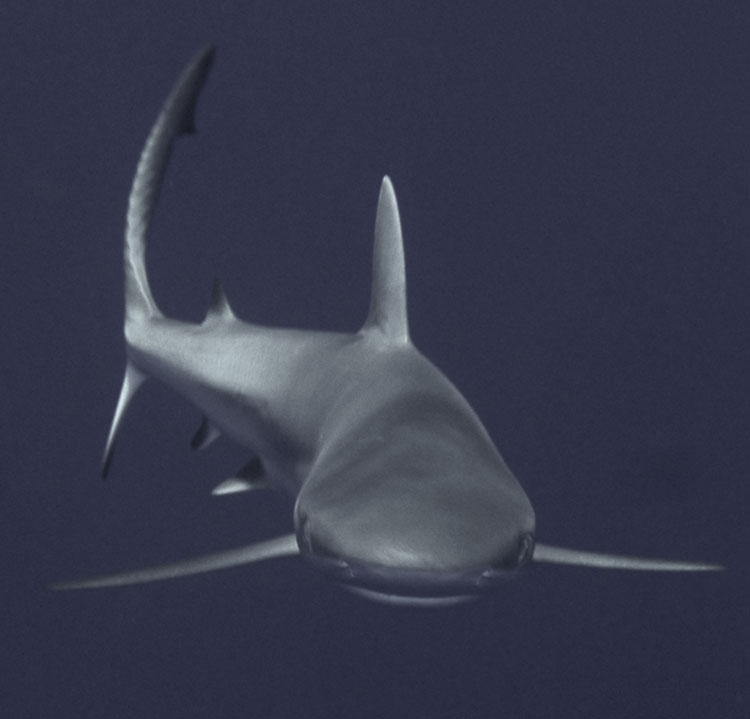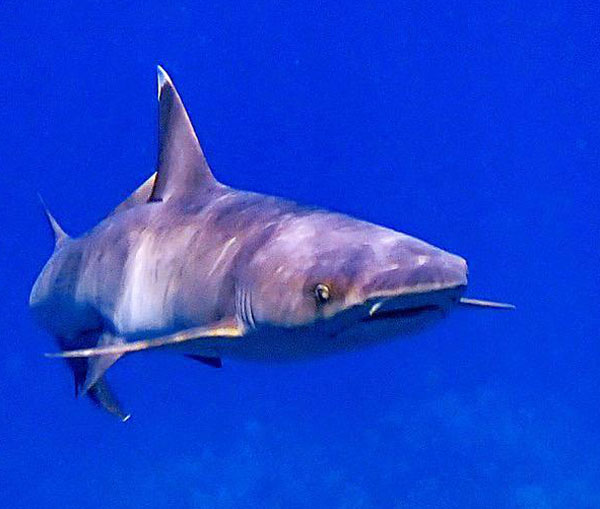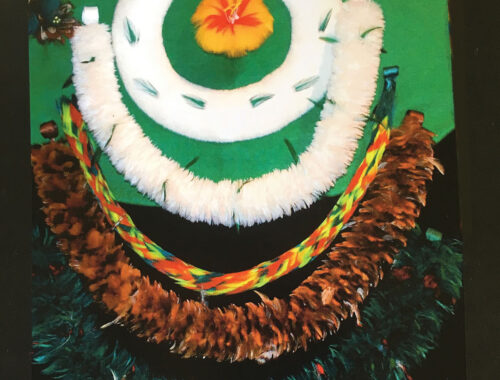
E Palekana Me Ka Manō: Be Safe With Sharks

By Wendy Noritake
I have a daily ritual of swimming in the ocean, enjoying nature, and anticipating what magic I might see. One morning in October, I swam with a friend in the warm turquoise waters at Nishimura Bay, in North Kohala. Over the large volcanic boulders near what’s called “China Wall,” I could see a shark heading toward me, its body swishing back and forth as it approached. There was no mistaking that movement, the head swinging in one direction, the tail in another.
As a PADI dive master, I’ve been scuba diving for more than 20 years, escorting groups of divers all over the world. I’ve spent a lot of time around sharks—tigers, oceanic white tips, hammerheads, Galapagos, nurses, also white and black tip reef sharks. I’ve done night dives while dozens of sharks frenetically fed off the reef fish, often following the ulua (giant trevally) who would stir up the smaller fish.
It’s always breathtaking to see one of the top predators of the ocean realm. I have a huge respect for these magnificent creatures who command attention, their large bodies sleek and muscular. Sharks play an important role in the ecosystem, keeping the reefs and oceans in balance. It’s the humans who are creating the imbalance, killing millions of sharks each year by cutting off their fins for soup and leaving them to die, unable to swim. Fishing nets, long line fishing, disease, garbage, and climate change all contribute to their declining numbers.
A Bad Rap
Because I have dived frequently with sharks, I find that they aren’t interested in humans. Sharks aren’t even attracted to human blood or urine, but they are attracted to certain fish blood. They’re curious creatures who investigate. Their mouths are sensory organs and they taste something by biting. The Jaws movies and Shark Week shows, which portray them as vicious, man-eating killers, have given them a bad rap. More people die from snake bites than fall prey to a shark. The Florida Museum of Natural History’s International Shark Attack File (ISAF) reported only six shark attacks in Hawai‘i in 2021, and no fatalities. They also reported that 39 percent of shark attacks worldwide were to swimmers, six percent to body surfers, and four percent to snorkelers and free divers.

Be Akamai
As the shark at Nishimura Bay came within a couple of feet, I briefly wondered if I might have to use a redirection maneuver, basically a means to push it away. I learned this from Ocean Ramsey, a marine biologist and conservationist who specializes in the sharks of Hawai‘i. I’ve not had to use the tactic, but I’ve seen her do it many times in her videos. Locking your elbow with arm straight, you push the shark’s nose and head down and away from you. It’s a tactic similar to martial arts, using the opponent’s momentum to push it past you. Don’t put your hand under the nose or head of the shark, but on top. You don’t want your hand to accidentally go inside its mouth!

Acutely aware as the shark approached, I pirouetted around, making myself as upright and as large as possible. I never took my eyes off the shark as it made a sweeping 360 degree turn around me. I snapped photos as I watched. Then, the shark came in close again. I could tell by the white triangle on the dorsal fin that it was a white tip reef shark, not known to attack humans, but they are inquisitive and territorial.
As it came toward me that second time, I faced it with my fins in front of me, batting it away. The next moment, the shark veered off and swam into the blue. I let out a sigh of relief through my snorkel. With the excitement and adrenalin rush, what seemed to take hours in slow motion probably took less than a minute.
Swimming on the surface of the sea is far different from scuba diving with sharks, and connecting with them at eye level. We are in their backyard, their terrain, every time we enter the ocean. At the surface, you might look like an injured fish or animal, splashing and kicking through the water. It’s always a good idea to look directly behind you often when you’re swimming in open water, because that’s how sharks can approach, from behind and by surprise.
One of my freediving friends recently showed me a video he had taken as a result of turning to look back while he was swimming. He faced the shark that was coming directly at him. It swam just below the surface, and I’m sure the dorsal fin was cutting through the water like a knife. The shark swiftly moved in, but finally it turned and swam away. That’s when I noticed the vertical gray stripes on its body: a tiger shark. That is not a scene I wish to encounter.
Never swim by yourself in open water if you can help it. A couple of years ago three of us were caught in a nasty current at Kaiholena, a bay on the Kohala Coast. We were struggling to swim back to the entry point, literally crawling and inching along. That’s when the large white tip shark appeared. It swam below and to the right of me, and I thought, “Oh no, here we are, flailing and kicking like injured seals, and looking like dinner!” I truly believed that it wouldn’t have done anything even if I was by myself, but because there were three of us, we may have looked too large to bother with. After a while, it tired of us and swam away. If you are swimming alone, staying closer to the reef or shoreline is better than deep, open water.

I always wear a Sharkbanz on my ankle when snorkeling. It houses a powerful magnet which supposedly disrupts the magnetic field in their brains and causes them to bolt. I’ve seen videos where bait was hung off a boat along with a Sharkbanz, and sharks would come to the bait ball and abruptly move away. I have also seen where sharks swam to the bait ball and ripped it off the rope along with the band. I tell myself that I would be satisfied if it worked just once. Maybe it did.
When I told my freediving instructor about my shark encounter, he reminded me that our conversation was during “Sharktober.” Our local kupuna, Aunty Maile Spencer Napoleon, confirmed that “this [October] is the time of year when the wiliwili trees are in bloom and the sharks are biting.”
Aunty Maile went on to say that the ancient Hawaiians had documented the creation story in the Kumulipo, a chant that has been carried down through the generations. It speaks of the land and plants in relation to the ocean and its creatures, and how humans are affected. In Hawai‘i, some families and individuals believe that sharks are their ‘aumākua, (deified ancestors) bringing good luck blessings and a watchful presence over the household. All are sacred, we are all connected, and we have no reason to be fearful.
That said, I do believe we need to have some amount of fear, and not let our guard down while we’re in the ocean. Don’t take anything for granted. ❖
For more information: wendynoritake@mac.com



